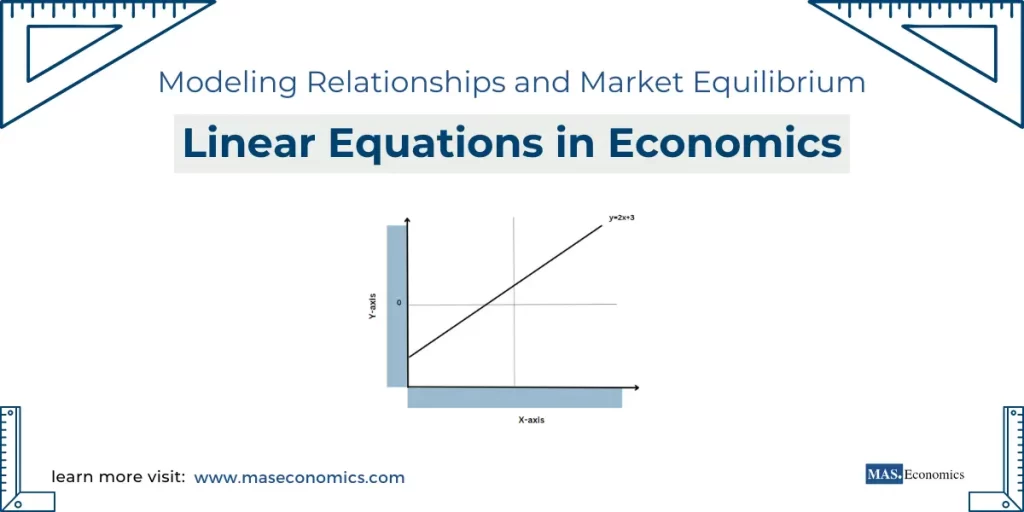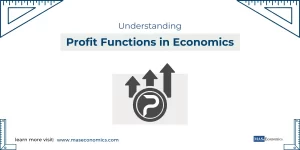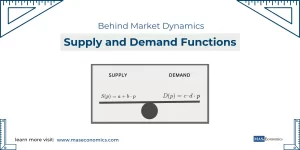Linear equations are the cornerstone of economic analysis, providing a way to model relationships between economic variables in a straightforward and manageable manner. Whether it is determining the relationship between supply and demand, calculating cost functions, or finding equilibrium points in the market, linear equations are an essential tool for economists. Understanding how these equations work and how they can be manipulated is key to creating economic models that accurately represent real-world scenarios.
What Are Linear Equations?
A linear equation is an algebraic equation in which each term is either a constant or the product of a constant and a single variable. Linear equations are characterized by their simplicity, as they can be visualized as straight lines when plotted on a graph. The general form of a linear equation with one variable is:
\(ax + b = 0\)
In which:
- \(a\) and \(b\) are constants.
- \(x\) represents the variable of interest.
Linear equations are used to represent a wide range of economic relationships, such as price and quantity, income and consumption, and supply and demand. These relationships help economists understand how changes in one variable might affect another.
Linear Equations with One Variable in Economics
Normal Form and Solving Linear Equations
A linear equation with one variable can be solved by isolating the variable on one side of the equation. This process involves equivalent transformations to balance both sides until the solution is found. For example, consider the linear equation:
\(50x + 40 = -10x\)
Using equivalent transformations to solve for \(x\):
\(60x = -40\)
\(x = \frac{-2}{3}\)
The solution for \(x\) represents the value that makes both sides of the equation equal. In economics, such solutions are important for identifying equilibrium values—points at which market forces balance.
Practical Example: Finding Break-Even Points
A typical use of linear equations in economics is to determine break-even points, where total cost equals total revenue, resulting in neither profit nor loss. If the cost function is represented by \(C(x) = 50x + 200\) and the revenue function is represented by \(R(x) = 70x\), we find the break-even point by setting \(C(x) = R(x)\):
\(50x + 200 = 70x\)
Solving for \(x\):
\(20x = 200\)
\(x = 10\)
This means the firm breaks even when it sells 10 units of its product.
Linear Equations with Multiple Variables
Linear equations can also involve multiple variables, allowing for more complex relationships. The general form of a linear equation with multiple variables is:
\(a_1x_1 + a_2x_2 + \cdots + a_nx_n = b\)
In which:
- \(a_1, a_2, \ldots, a_n\) are constants representing coefficients.
- \(x_1, x_2, \ldots, x_n\) are the variables.
- \(b\) is the constant term.
In economics, multiple-variable linear equations can be used to model systems where several factors influence an outcome. For example, the demand function might depend on multiple factors like income, prices of substitutes, and consumer preferences.
Practical Example: Supply and Demand Equilibrium
Consider a simple economic model where supply and demand are functions of price (\(P\)) and other variables like income (\(I\)). Suppose we have the following linear equations representing supply and demand:
Supply Equation:
\(Q_s = 3P + 5\)
Demand Equation:
\(Q_d = 50 – 2P\)
To find the equilibrium price (\(P^*\)) and equilibrium quantity (\(Q^*\)), we set \(Q_s = Q_d\):
\(3P + 5 = 50 – 2P\)
Solving for \(P\):
\(5P = 45\)
\(P = 9\)
Substituting \(P = 9\) back into either the supply or demand equation to find \(Q^*\):
\(Q_s = 3(9) + 5 = 32\)
Thus, the equilibrium price is 9, and the equilibrium quantity is 32.
Systems of Linear Equations in Economic Modeling
A system of linear equations consists of multiple linear equations that involve the same set of variables. Systems of linear equations are used in economics to determine the values of multiple variables simultaneously. This is especially important in models involving multiple markets or sectors.
Solving Systems of Linear Equations
There are several methods to solve systems of linear equations, including the substitution method, elimination method, and matrix method. Let’s explore how these methods can be applied to economic modeling.
Substitution Method
The substitution method involves solving one equation for one variable and substituting this value into another equation. Consider the following system of equations:
\(3x + 2y = 15\)
\(x – y = 3\)
To solve this system:
- Solve the second equation for \(x\):
- Substitute \(x = y + 3\) into the first equation:
- Expand and solve for \(y\):
- Substitute \(y = 1.2\) back into \(x = y + 3\):
\(x = y + 3\)
\(3(y + 3) + 2y = 15\)
\(3y + 9 + 2y = 15\)
\(5y = 6\)
\(y = 1.2\)
\(x = 4.2\)
Thus, the solution set is \(x = 4.2, y = 1.2\).
Elimination Method
The elimination method involves adding or subtracting equations to eliminate one of the variables. This is particularly effective when dealing with larger systems of equations. For instance, consider:
\(2x + 3y = 12\)
\(3x – y = 5\)
To solve this system:
- Multiply the second equation by 3 to align the coefficients of \(y\):
- Add the modified equations to eliminate \(y\):
- Substitute \(x = 2.45\) back into one of the original equations to find \(y\).
\(9x – 3y = 15\)
\((2x + 3y) + (9x – 3y) = 12 + 15\)
\(11x = 27\)
\(x = \frac{27}{11} \approx 2.45\)
Applications of Linear Equations in Economics
Linear equations are used in a wide range of economic applications, such as modeling supply and demand, cost functions, and income distribution. These models are essential for making predictions, optimizing resource allocation, and understanding how different variables interact in an economic system.
Cost and Revenue Analysis
Cost functions and revenue functions are often linear, especially in the short run. For example, a cost function might be expressed as:
\(C(x) = 100 + 5x\)
In which \(C(x)\) represents the total cost of producing \(x\) units, with a fixed cost of 100 and a variable cost of 5 per unit. By equating the cost function to a linear revenue function like \(R(x) = 20x\), we can determine the break-even point and evaluate profitability.
Market Equilibrium
Linear equations are also crucial in determining market equilibrium, where supply equals demand. Market models often involve setting two linear equations equal to solve for the equilibrium price and quantity, as demonstrated earlier in this post. This approach helps policymakers and economists predict how shifts in supply or demand might impact the market.
Conclusion
Linear equations are fundamental to economic modeling, offering a powerful yet simple way to represent relationships between variables. By using techniques such as solving for single or multiple variables and applying methods like substitution and elimination, economists can analyze and predict outcomes in various economic scenarios.
FAQs:
What are linear equations, and how are they used in economics?
Linear equations are algebraic equations where each term is either a constant or the product of a constant and a variable. In economics, they model relationships between variables such as price and quantity, income and consumption, or supply and demand. They help economists analyze and predict how one variable affects another.
How do you solve linear equations with one variable?
To solve a linear equation with one variable, isolate the variable by performing equivalent transformations. For example, solving the equation \(5x + 10 = 60\) yields \(x = 10\). This solution method is useful in economics for identifying equilibrium values, such as market prices or quantities.
What is a break-even point, and how is it calculated using linear equations?
A break-even point occurs when total cost equals total revenue, resulting in no profit or loss. If the cost function is \(C = 50 + 5q\) and the revenue function is \(R = 10q\), setting \(C = R\) and solving for \(q\) gives the break-even quantity. In this case, the firm breaks even by producing and selling 10 units.
How are linear equations with multiple variables used in economics?
Linear equations with multiple variables model more complex relationships involving several factors. For example, demand might depend on variables such as price, income, and prices of substitutes. These equations are essential in multi-variable economic models, such as supply-demand systems or multi-sector analyses.
How do you determine supply and demand equilibrium using linear equations?
To find equilibrium, set the supply and demand functions equal. For example, if supply is \(Q_s = 3P – 6\) and demand is \(Q_d = 30 – 2P\), setting \(Q_s = Q_d\) allows you to solve for the equilibrium price and quantity. This helps in predicting market outcomes and understanding price-setting behavior.
What are systems of linear equations, and how are they solved?
A system of linear equations consists of multiple equations with the same variables. These systems can be solved using substitution (solving one equation for a variable and substituting it into another) or elimination (adding or subtracting equations to eliminate a variable). Matrix methods are also used for larger systems.
How are linear equations applied in cost and revenue analysis?
Cost and revenue functions are often modeled using linear equations. For example, a cost function \(C = 100 + 5q\) shows fixed and variable costs. By comparing this with a revenue function, such as \(R = 10q\), you can calculate profitability, break-even points, and production levels for optimal performance.
Thanks for reading! Share this with friends and spread the knowledge if you found it helpful.
Happy learning with MASEconomics




